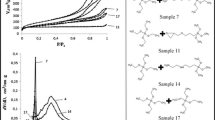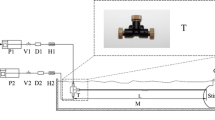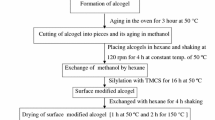Abstract
Silica gel has been prepared by the hydrolysis of TEOS under three different pH conditions. These gels have been subjected to drying in an air oven, under humidity, and also by exposure to microwaves, followed by further calcination at 500°C under slow heating schedule (3°C/min). Silica samples thus obtained are characterised by B.E.T. specific surface area and pore volume data. The thermal decomposition behaviour of the precursor gels are also reported. The adsorption isotherms of these samples indicate different behaviour related to the method of synthesis. Increase in pH of hydrolysis of the TEOS from 3 to 8 results in increase in specific surface area in tune with the earlier reports. However more significant observation is the variation in pore size distribution as evidenced from adsorption isotherms related to method of drying. Silica gels prepared at pH 3 show Type I behaviour irrespective of the method of drying. However gel prepared at pH 6 shows Type II behaviour when dried under microwave with specific surface area as high as 635 m2/g and pore volume 0.9733 cc/g. The precursor gels prepared at still higher pH exhibit Type IV behaviour when subjected to microwave drying. The pH conditions of synthesis of precursor gels along with drying techniques appear to affect not only the surface areas and porosities but also the resultant adsorption isotherms, in sol-gel silica.
Similar content being viewed by others
References
P.H. Tewari, A.J. Hund, and K.D. Lofftus, in Proceedings of the1st International Symposium on Aerogels, edited by J. Fricke, Springer Proceedings in Physics (Springer, Heidelberg, 1986), Vol. 6, p. 31.
T. Woigner, J. Phalippou, and M. Prassas, J. Mater. Sci. 25, 3118 (1990).
S.H. Hyun and B.S. Kang., J. Am. Ceram. Soc. 77, 3093 (1994).
Y. Yan, S.R. Chaudhuri, and A. Sarkar, J. Am. Ceram. Soc. 79, 1061 (1996).
B. Pommier and S.J. Teichner, in Proceedings of the 9th International Congress on Catalysis 1988), Vol. 2, p. 610.
S.P. Mukherjee, J. Non Cryst. Solids 63, 35 (1984).
B.E. Yoldas, J. Non Cryst. Solids 48, 145 (1984).
C.J. Brinker, K.D. Keefer, D.W. Schaefer, and C.S. Ashley, J. Non Cryst. Solids 48, 47 (1982).
B.E. Yoldas, J. Mater. Sci. 14, 1843 (1979).
B.E. Yoldas, J. Non Cryst. Solids 51, 105 (1982).
N. Tohge, G.S. Moore, and J.D. Mackenzie, J. Non Cryst. Solids 63, 95 (1984).
C.J. Brinker, K.D. Keefer, D.W. Schaefer, R.A. Assink, B.D. Kay, and C.S. Ashley, J. Non Cryst. Solids 63, 45 (1984).
E.J.A. Pope and J.D. Mackenzie, J. Non Cryst. Solids 87, 185 (1988).
C.J. Brinker and G.W. Scherer, Sol-Gel Science: The Physics and Chemistry of Sol-Gel Processing (Academic Press, New York, 1990), p. 103.
M. Nogami and Y. Moriya, J. Non Cryst. Solids 37, 191 (1980).
F. Hayashi, K. Takei, Y. Machii, and T. Shimazaki, J. Cer. Soc. Jpn. Int. Edn. 98, 670 (1990).
B.S. Shukla and G.P. Johari, J. Non Cryst. Solids 101, 263 (1988).
A.M. Buckley and G.M. Greenblatt, J. Non. Cryst. Solids 143, 1 (1992).
H.M. Hakuman, H. Joh, M. Sakurai, and K. Nakai, Ceramic Transaction, Porous Materials, edited by Izhizaki, Sheppard, Okada, Haamasaki, and Huybrechts (Westerville, Ohio, 1993), Vol. 31, p. 203.
U.S. Hareesh, A.D. Damodaran, and K.G.K. Warrier, Brit. Ceram. Tran. 96, 99 (1997).
R.A. Laudise and D.W. Johnson, Jr., J. Non Cryst. Solids 79, 155 (1986).
E.H. Moore, D.E. Clark, and R. Hutcheon, Microwaves: Theory and Applications in Materials Processing II, edited by D.E. Clark, W.R. Tinga, and J.R. Laia, Jr. (Wester Ville, Ohio, 1993), p. 325.
W.H. Sutton, Microwaves: Theory and Applications in Materials Processing, edited by D.E. Clark, W.R. Tinga, and J.R. Laia, Jr. (Wester Ville, Ohio, 1993), p. 3.
S. Brunaeur, P.H. Emmett, and E. Teller, J. Am. Chem. Soc. 60, 309 (1938).
C.J. Brinker and G.W. Scherer, Sol-Gel Science: The Physics and Chemistry of Sol-Gel Processing (Academic Press, New York, 1990), pp. 477, 508.
Author information
Authors and Affiliations
Rights and permissions
About this article
Cite this article
Rajeshkumar, S., Anilkumar, G., Ananthakumar, S. et al. Role of Drying Techniques on the Development of Porosity in Silica Gels. Journal of Porous Materials 5, 59–63 (1998). https://doi.org/10.1023/A:1009625914689
Issue Date:
DOI: https://doi.org/10.1023/A:1009625914689




